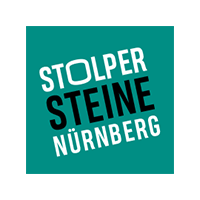Speech from Bernd Siegler
Bruno Einstein was born on 14 April 1894 in Obbach near Schweinfurt as the third child of the Jewish couple Dr. Theodor Einstein and his wife Johanna. The couple had four children: Bruno, Adele, Julius and Sigurd. In 1915, the family moved to Nuremberg.
Bruno Einstein was active as a shop assistant and later as a businessman. He first lived in Nuremberg at Enderleinstraße 13. During World War I, he was a member of the Royal Bavarian Flying Corps in Schleissheim. In December 1921, he married Anna Margarete Weiher from Eschenau, who was a Protestant.
On 1 October 1926, Bruno Einstein joined the Nuremberg Football Club as a passive member. In 1933, he registered his “Einstein & Wunderlich Commercial Representatives” as a business. The couple had no children and last lived in Peter-Henlein-Strasse 48.
On 30 April 1933, the Club expelled him from their ranks and marked this with a stamp on his membership card “30. APR. 1933”. After Hitler took power, Bruno and Anna Margarete Einstein left Germany. The registry office of the city of Nuremberg noted on 16 September 1933: “address unknown” – and a short time later, on 4 October: “moved, destination unknown”. On 12 April 1937, both were deprived of their German citizenship and their assets were confiscated.
By that time, the Einsteins were already in France. With the exception of the eldest sister Adele, all of the Einstein siblings fled to France. Julius went to Clermont-Ferrand and emigrated in December 1946 to the USA. Sigurd died on 10 October 1934 in the Hospital Lariboisière in Paris.
Bruno Einstein joined the Foreign Legion in order to receive French citizenship. From December 1939 to October 1940, he was stationed as a volunteer in Algeria. Afterwards, he returned to Clermont-Ferrand.
Bruno Einstein then moved to Billom in the Region Auvergne-Rhône-Alpes. There he worked in a sawmill, pottery and carpentry workshop at the entrance to the village of Billom. These businesses were founded and managed by Pierre Pottier. He was the leader of the resistance movement in the Billom district. In the resistance, he operated under the alias “Athos” and his factory became the nucleus of the resistance to the occupation.
Among his almost 100 employees are many Jews and refugees from eastern France (Alsace and Lorraine), who have defied the orders of the Vichy regime to work in support of the German war economy. They create a secret cache of weapons and munition.
In Canton Billom, there are 230 armed men who fight against the German army. Bruno Einstein was accepted as fighter in the resistance group of the Pottier factory. He took part in their activities such as lightning raids, smuggling gasoline and transportation of weapons. In the resistance he belonged to the so-called Forces françaises de l’intérieur (F.F.I.).
On 16 December 1943, German soldiers destroyed the resistance network in Billom. There were almost 2,000 soldiers that took part in the action, led by Hugo Geissler, the notorious commander of the Security Police and the Security Service (SD) of the Vichy regime. They set up roadblocks, searched the Pottier factory and arrested 45 resistance fighters. Twenty of them, including Bruno Einstein, were taken to the barracks of the 92nd Infantry Regiment of Clermont-Ferrand, tortured and then executed on 20 December 1943.
In 1947, Bruno Einstein was accorded a special honor: He officially received the title “Mort pour la France” (“Died for France”). His name is engraved on the memorial column in front of the Pottier factory and can be found on the monument for the “War Dead of 1939 – 1945 and the Resistance” in Billom.
In this small town, the memory of the raid of 1943 remains alive. Each year, a memorial service is held on the day of the execution of the resistance fighters. In the speech given by the mayor on the 70th anniversary of the tragedy he said: “These men were killed because they wanted to help other resistance fighters or refugees or simply because they were in possession of a radio transmitter. Simple gestures and risks for the preservation of our values: Freedom, equality, brotherhood. Their example is today the reason for our pride.”
At the beginning of 1968, Anna Margarete Einstein returned to Nuremberg. She lived at the home for the aged at Veilhofstrasse 34. At the registry office, she stated that her husband was shot on 20 December 1943 “at the shooting range of the 92nd Infantry Regiment” in Billom. These details, according to a note on her registration card, were confirmed by a letter from the city of Billom.
Anna Margarete Einstein died on 26 June 1971 in Nuremberg.



